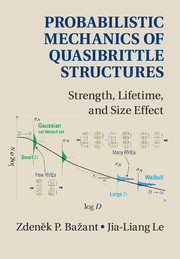Book contents
- Frontmatter
- Dedication
- Contents
- Foreword
- Preface
- 1 Introduction
- 2 Review of Classical Statistical Theory of Structural Strength and Structural Safety, and of Statistics Fundamentals
- 3 Review of Fracture Mechanics and Deterministic Size Effect in Quasibrittle Structures
- 4 Failure Statistics of Nanoscale Structures
- 5 Nano–Macroscale Bridging of Probability Distributions of Static and Fatigue Strengths
- 6 Multiscale Modeling of Fracture Kinetics and Size Effect under Static and Cyclic Fatigue
- 7 Size Effect on Probability Distributions of Strength and Lifetime of Quasibrittle Structures
- 8 Computation of Probability Distributions of Structural Strength and Lifetime
- 9 Indirect Determination of Strength Statistics of Quasibrittle Structures
- 10 Statistical Distribution and Size Effect on Residual Strength after Sustained Load
- 11 Size Effect on Reliability Indices and Safety Factors
- 12 Crack Length Effect on Scaling of Structural Strength and Type 1 to 2 Transition
- 13 Effect of Stress Singularities on Scaling of Structural Strength
- 14 Lifetime of High-k Gate Dielectrics and Analogy with Failure Statistics of Quasibrittle Structures
- Appendix A Power-Law Scaling of Boundary Value Problems
- Appendix B Proof of Transitional Size Effects of Types 1 and 2 by Dimensional Analysis and Asymptotic Matching up to Second Order
- Appendix C Proof of Small-Size Asymptotics of Cohesive Crack Model up to Second Order
- References
- Author Index
- Subject Index
Preface
Published online by Cambridge University Press: 14 June 2017
- Frontmatter
- Dedication
- Contents
- Foreword
- Preface
- 1 Introduction
- 2 Review of Classical Statistical Theory of Structural Strength and Structural Safety, and of Statistics Fundamentals
- 3 Review of Fracture Mechanics and Deterministic Size Effect in Quasibrittle Structures
- 4 Failure Statistics of Nanoscale Structures
- 5 Nano–Macroscale Bridging of Probability Distributions of Static and Fatigue Strengths
- 6 Multiscale Modeling of Fracture Kinetics and Size Effect under Static and Cyclic Fatigue
- 7 Size Effect on Probability Distributions of Strength and Lifetime of Quasibrittle Structures
- 8 Computation of Probability Distributions of Structural Strength and Lifetime
- 9 Indirect Determination of Strength Statistics of Quasibrittle Structures
- 10 Statistical Distribution and Size Effect on Residual Strength after Sustained Load
- 11 Size Effect on Reliability Indices and Safety Factors
- 12 Crack Length Effect on Scaling of Structural Strength and Type 1 to 2 Transition
- 13 Effect of Stress Singularities on Scaling of Structural Strength
- 14 Lifetime of High-k Gate Dielectrics and Analogy with Failure Statistics of Quasibrittle Structures
- Appendix A Power-Law Scaling of Boundary Value Problems
- Appendix B Proof of Transitional Size Effects of Types 1 and 2 by Dimensional Analysis and Asymptotic Matching up to Second Order
- Appendix C Proof of Small-Size Asymptotics of Cohesive Crack Model up to Second Order
- References
- Author Index
- Subject Index
Summary
Although some would vehemently deny it, many specialists would agree that, since the 1977 death of Freudenthal, the research field of structural safety and reliability has been in a schism.
Alfred Freudenthal, the founder of this field of research in the 1960s, perceived the fields of (1) structural safety and (2) mechanics and physics of materials and structures as inseparable. He mastered both, and treated both to the depth of knowledge in his time. Since that time, unfortunately, most researchers have immersed themselves in one of these two fields in great detail and with high sophistication, while treating the other aspect simplistically and superficially. The connection has been weak.
On one side, there have been probabilists who develop and successfully market complex computer programs to assess safety, reliability, and lifetime of concrete structures without recognizing that failure probability of concrete structures cannot be predicted with simplistic or obsolete material models that eschew fracture mechanics and energetic size effect. Or there have been statistically minded experimenters who conduct extensive histogram testing of the strength of ceramics but ignore the scale effects, micromechanics, and microscale physics of failure.
On the other side, there have been mechanicians who construct highly refined constitutive and computational models for the mechanics of failure of concrete, geomaterials, and composites without recognizing that far greater prediction errors stem from simplistic or nonexistent treatment of the randomness of the material as well as the loads.
The present book attempts a step to rectify this schism. In a unified theoretical framework, it deals with the quasibrittle structures, which are those consisting of quasibrittle (or brittle heterogeneous) materials. These are commonplace materials, used more and more widely and increasingly important for modern technology, including much of high-tech. They encompass concretes (as the archetypical case), rocks, fiber composites, tough ceramics, sea ice, bone, wood, stiff soils, rigid foams, and so forth, as well as all brittle materials on the micrometer scale. They are characterized by a fracture process zone that is not negligible compared to the typical structural dimensions. This feature causes an intricate energetic size effect, which is intertwined with the classical statistical size effect, the only kind of size effect known in classical fracture mechanics of brittle materials.
- Type
- Chapter
- Information
- Probabilistic Mechanics of Quasibrittle StructuresStrength, Lifetime, and Size Effect, pp. xv - xviPublisher: Cambridge University PressPrint publication year: 2017



